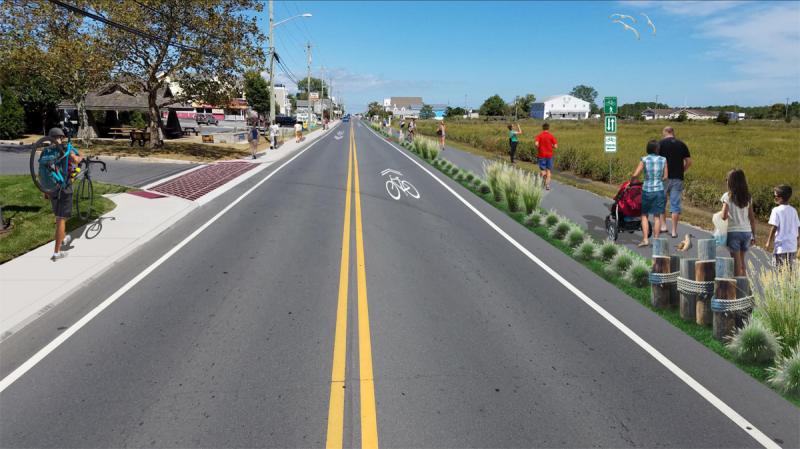The pedestrian improvement project along the beach side of Savannah Road in Lewes will cost the city about $250,000 – and that doesn’t sit well with at least one council member.
Councilwoman Bonnie Osler, treasurer, said the project would put a significant strain on the city’s budget. Coupled with all the upcoming capital projects proposed for this fiscal year, she said, the city’s reserves would be drained by 45 percent. While this project would likely spread over multiple fiscal years, Osler said, the city still has no way to regenerate the necessary funds.
“The money is gone or it is going,” she said. “We don’t have a ready source for refilling our capital accounts, except transfer taxes, unless we borrow or raise taxes.”
A concept plan was presented to the public in December. The plan is to add an 8- to 10-foot-wide separated, shared two-way path along the marsh that runs parallel to Savannah Road from the Lewes-Rehoboth Canal bridge to the beach, while also including new pedestrian crosswalks, a new sidewalk on the side opposite the marsh and landscaping improvements. An outlook on American Legion Road would provide people with a view of the marsh.
Gail van Gilder, chair of the byways committee, said the idea is to reduce vehicular traffic on Savannah Road by offering a safe alternative route to the beach. The plan was included in the Historic Lewes Byway: Gateway to the Bayshore’s corridor management plan, which was accepted by the state, county and city last year.
The byways committee submitted an application for the project to the Department of Transportation’s Transportation Alternatives Program, which uses money from the Federal Highway Administration to fund various projects statewide.
There are about 25 projects statewide in various stages of the TAP process, said Ann Gravatt, DelDOT planning supervisor in charge of the program. All projects are capped at $1 million to ensure funding is available for multiple projects.
TAP projects are funded through an 80-20 partnership between the federal funds and a local sponsor. In the case of the Savannah Road project, the city of Lewes is the local sponsor funding 20 percent of the project.
The Savannah Road project is estimated to cost about $1.2 million, meaning it would have to be split into two phases. Lewes City Manager Paul Eckrich said the first phase would include work from the Lewes-Rehoboth Canal bridge to American Legion Road.
If the city decides to move forward, the next step would be the design phase, expected to last about a year. The cost is estimated at $83,000, with the city’s portion about $16,000.
The first construction phase would follow, estimated at about $620,000. The city’s portion would be about $124,000. The second construction phase carries a similar price tag.
“I think we have to ask ourselves more searingly than usual what we’re getting ourselves into,” Osler said. “I have no doubt this is a great project, but it’s our job to prioritize.”
Gravatt said if the city defers the project, it could be lost altogether. Speaking from a tourist’s point of view, Gravatt said, the project would not only make the stretch of road safer for bicyclists and pedestrians, but it would enhance the public’s perception of Lewes.
“Tourists will look at Lewes as progressive,” she said. “I really believe your return on investment is going to be much more than what you put into this project.”
She said her department is willing to work with the city to expand timelines to make the project more financially viable.
“But we won’t wait 10 years,” she said.
The project could be part of a larger effort to expand the trail system in and around Lewes. The Department of Natural Resources and Environmental Control is currently studying the feasibility of adding a trail along the railroad tracks from Freeman Highway to Cape Henlopen State Park, with a link to the Cape May-Lewes Ferry terminal.
Heath Gehrke, director of ferry operations for the Delaware River and Bay Authority, sent a letter to Mayor Ted Becker in support of the project, specifically the two-way separated bike path.
“The completion of this path will serve as an asset to the community and the region,” he said. “It will provide an additional opportunity for residents and visitors to utilize an alternative, safe, healthy mode of transportation.”
More than 4,000 bicyclists use the ferry each year, he said, with many others renting bicycles once they arrive in Sussex County.
Osler said her concerns are raised knowing there may be more projects in the future and the city may be on the hook for more money.
“I don’t have a clue what that would cost and who would pay for it,” she said. “My assumption is that the city will pay for a piece of it. We’re not going to have that money, absent borrowing it.”
Chip Kneavel, DelDOT project manager, said the Savannah Road project covers many of the recommendations offered in the marine-commercial district study by the city’s planning consultant Environmental Resources Management as well as the byways committee’s Corridor Management Plan.
“Unless those documents aren’t in line with what the city wants to do,” he said.
Osler said it isn’t about what they city wants to do, but rather how it’s going to affect the bottom line.
“There is no question this project, like so many other projects, is desirable and would enhance the city,” she said. “I don’t think that’s what the issue is. The professionals who wrote this up didn’t have fiscal constraints, but we do.”
While the project has support of the byways committee, it does not have support from the city’s bicycle and pedestrian safety advisory committee. At a recent byways meeting, Chairman Mike Tyler said his group plans to recommend city council abandon the plan.
Tyler said the plan promotes wrong-way cycling and creates a conundrum when bicyclists reach the bridge, where they would be forced to walk their bicycles across the bridge or ride across on the wrong side of the road.
“We feel this plan is awful,” he said. “It’s an awful plan that creates such a dilemma for bicyclists and pedestrians, and it’s terribly unsafe when you get to the bridge. If our committee would’ve been invited, I think we would’ve given you some valuable input before it ever happened.”
Byways member David Stuart, an avid cyclist and member of Sussex Cyclists, offers a different, more positive view of the proposed project. He often rides with his grandchildren, utilizing existing bike paths where possible. As for Savannah Road, he said, the proposed improvements offer a much safer way for families with children to travel to and from the beach.
“My grandchildren love to travel by bicycle with us, but they are not yet experienced to safely travel on roadway shoulders,” he said. “We simply will not have our 6-year-old grandchildren ride on roadway bicycle lanes; it is too dangerous, especially in summer when they must compete with tourist auto and SUV traffic.”
According to a recent article by the State Smart Transportation Initiative, a wealth of evidence is accumulating in support of protected bike lanes. The article highlights a significant drop in bicycle crashes and injury rates in Minneapolis, where protected bike lanes were built out throughout the city.
City council did not make any decisions on the proposed Savannah Road project March 2. Officials have until the beginning of the new budget year April 1 to decided whether to include funding for the project in the coming fiscal year. Council will next meet at 1 p.m., Thursday, March 9, at city hall.
Nick Roth is the news editor. He has been with the Cape Gazette since 2012, previously covering town beats in Milton and Lewes. In addition to serving on the editorial board and handling page layout, Nick is responsible for the weekly Delaware History in Photographs feature and enjoys writing stories about the Cape Region’s history. Prior to the Cape Gazette, Nick worked for the Delmarva Media Group, including the Delaware Wave, Delaware Coast Press and Salisbury Daily Times. He also contributed to The News Journal. Originally from Boyertown, Pa., Nick attended Shippensburg University in central Pennsylvania, graduating in 2007 with a bachelor’s degree in journalism. He’s won several MDDC awards during his career for both writing and photography. In his free time, he enjoys golfing, going to the beach with his family and cheering for Philadelphia sports teams.

























































